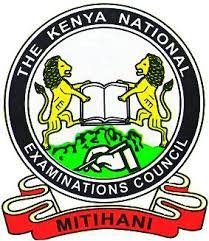
SECTION A: (25 marks)
1. State the reason why an object on earth has a heigher weight than on the moon. (1 mark)
2. Figure 1 shows the position of a students cye while illustrate the length of a wooden block using a theme rule.

Determine the 1cngth of’the block as viewcd by the student. (1 mark)
3. Describe how the knowledge of the oil drop experiment may be used to estimate the area of oil spillage from a ship in the sea assuming the sum face water is not distort bed. (3 marks)
4. Figure 2 shows an instrument used to measure atmospheric pressure.

State with a reason the modification that would be required in a similar set up if mercury were to be replaced with water. (2 marks)
5. It is observed that a drop of milk carefully put into a cup of water tums the water white after some time. State the reason for this observation. (1 mark)
6. Figure 3 shows the shape of a bimetallic strip after it was coolcd below room temperature.

Explain why the strip curved is as shown. (2 marks
)
7. A wooden cube of side 0.5m floats in water frilly submerged. Determine the weight of’the cube.density of the water = 1gm-3). (2 marks)
8. Figure 4 shows a stonc whirled in a veitical circle.

On the axes provided, sketch a graph of tension against time as the stone moves through point A, B, C and D. (3 marks)

9. Figure 5 shows a ball spinning as it moves.

(a) On the diagram, sketch the path followed by the ball as it moves.(1 mark)
(b) Explain why the ball takes that path.(3 mark)
10. Figure 6 shows the relationship between volume and pressure for a certain gas.

11. Figure 7 shows an L-shaped wooden structure.

On the diagram construct appropriate lines to show the position of’ the centre of gravity for the structrne. (2 marks)
12. Figure 8 shows the graph of extension against force for a certain helical spring.

On the same diagram sketch the graph of extension against force for a spring with a lower value of spring constant. (1 mark)
13. State two ways in which a mercury based thermometer can be modified to read very small temperature changes. (2 marks)
SECTION B (55 marks)
14. (a) State Evo differences between boiling and evaporation.(2 marks)
(b) State three ways in which loss of heat by conduction is minimised in a vacuum flask. (3 marks)
Determine the:
(i) quantity of heat lost by steam to change to water at 100 °C.(2 marks)
(ii) quantity of heat lost by water to cool to 0°C.(2 marks)
(iii) mass of ice melted at 0 °C.(2 marks)
15. (a) State Newton’s fiist law’ of motion. (1 mark)
(b) A wooden block resting on a horizontal bench is given an initial velocity u so that it slides on the bench for a distance x before it stops.
Various values of x are measured for different alnes of’tlie initial velocity. Figure 9 shows a graph of u’ against x.

(i) Determine the slope S of the graph. (3 marks)
(ii) Determine the value of k given that u’ = 20kd where k is a frictional constant for the sui tacc. (2 marks)
(iii) State with a reason what happens to the value of k when the roughness of the bench surface is reduced. (2 marks)
(c) An object is thrown vertically upwards with an initial velocity of 30 ms ‘. Determine its maximum height (acceleration due to gravity g is 10 mw’). (3 marks)
16. (a) An electie crane uses 8.0 x 10‘ N of energy to lift a load of 2.0 X 104 N in 4 s.
( i) Determine the
I power developed by the crane,(3 marks)
lI height to which the load is lifted, (2 marks)
111 efficiency of the crane whose motor is rated 2.5 X 10’W. (2 marks)
iii) Sure two forms of energy transformation that lead to the crane’s inefficiency. (2 marks)
(b) A stone is dropped from the top of a building to the ground. On the axes provided, sketch a graph of potential enemy against time for the stone. (1 mark)

17. (a) State Pascal’s principle of transmission of pressure in liquids. (b) Figure 10 shows heights of two immiscible liquids X and Y in a U-tube (drawn to scale)

(i) State with a reason which of the two liquids X and Y has a higher density. (2 marks)
(ii) Determine the value of h. (2 marks)
iii) Given that the density of liquid Y is p, write down an expression for the density d of liquid x in terms of p. (2 marks)
(c) ( i) With the aid of a diagram, describe how a liquid may be siphoned from one container to another using a flexible tube. (3 marks)
iii) Sums one application of the siphon. (1 mark)
18. (a) State two quantities that must be kept constant in order to verify Boyle’s law. (2 marks)
(b) An air bubble at the bottom of a beaker full of water becomes larger as it rises to the surface. State the reason why;
(i) the bubble rises to the surface,(1 marks)
(ii) it becomes larger as it rises.(1 marks)
(c) State two assumptions made in explaining the gas laws using the kinetic theory of gases. (2 marks)
(d) Figure 11 shows an incomplete experimental set up that was prepared by a student to verily one of the gas laws.
Thermometer Pressure gauge

i) State with a reason which one of the laws may be verified using the set up. (2 marks)
(ii) State what the student left out in the diagram of the set up. (1 mark)
(e) The volume of a fixed mass of a gas reduced from 500 cm3 to 300 cm3 at constant pressure. The initial temperature was 90K. Determine the final temperature. (3 marks)
